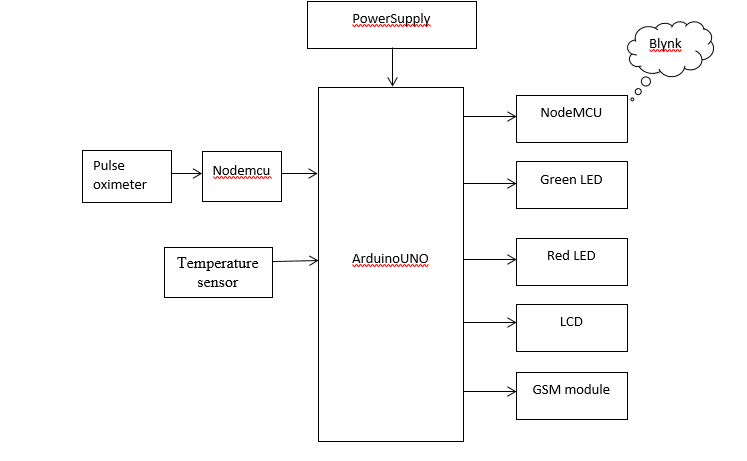Handy Non-Invasive Blood Glucose Estimator using Arduino and NodeMCU
Objective
The main objective of this project is to develop a non-invasive blood glucose estimator using Arduino and NodeMCU, providing a convenient and accessible means for individuals to monitor their blood glucose levels without the need for invasive procedures
Abstract
This project introduces an integrated health monitoring system that utilizes technology to measure essential health parameters such as blood oxygen saturation levels, heart rate, pulse strength, and body temperature. It employs a pulse oximeter and temperature sensor for non-invasive readings, displaying the data on an LCD for user convenience. A visual indicator, represented by green or red LEDs, signals normal or abnormal readings, providing feedback. The system extends beyond local interactions through NodeMCU, enabling remote data transmission to the Blynk platform for smartphone accessibility and healthcare provider sharing. Additionally, it offers a safety net by sending immediate alerts to caretakers via SMS or messaging in case of abnormal readings. This integration of non-invasive monitoring and technology empowers users to proactively manage their health, fostering a safer and more informed healthcare environment.
Keyword: Pulse oximeter, temperature sensor, NodeMCU, SMS,BlynkIOT.
NOTE: Without the concern of our team, please don't submit to the college. This Abstract varies based on student requirements.
Block Diagram

Specifications
Hardware Requirements:
- Arduino UNO
- Nodemcu
- Pulse oximeter
- Temperature Sensor
- LCD Display
- Red LED
- Green LED
- GSM Module
Software Requirements:
- Arduino IDE.
- Embedded C.
Learning Outcomes
- Arduino pin diagram and architecture
- How to install Arduino IDE software
- Setting up and installation procedure for Arduino
- Introduction to Arduino IDE
- Basic coding in Arduino IDE
- Working of LCD
- Interface LCD with Arduino
- Working of power supply
- About Project Development Life Cycle:
- Planning and Requirement Gathering (software’s, Tools, Hardware components, etc.,)
- Schematic preparation
- Code development and debugging
- Hardware development and debugging
- Development of the Project and Output testing
- Practical exposure to:
- Hardware and software tools.
- Solution providing for real time problems.
- Working with team/ individual.
- Work on Creative ideas.
- Project development Skills
- Problem analyzing skills
- Problem solving skills
- Creativity and imaginary skills
- Programming skills
- Deployment
- Testing skills
- Debugging skills
- Project presentation skills.





 Paper Publishing
Paper Publishing
